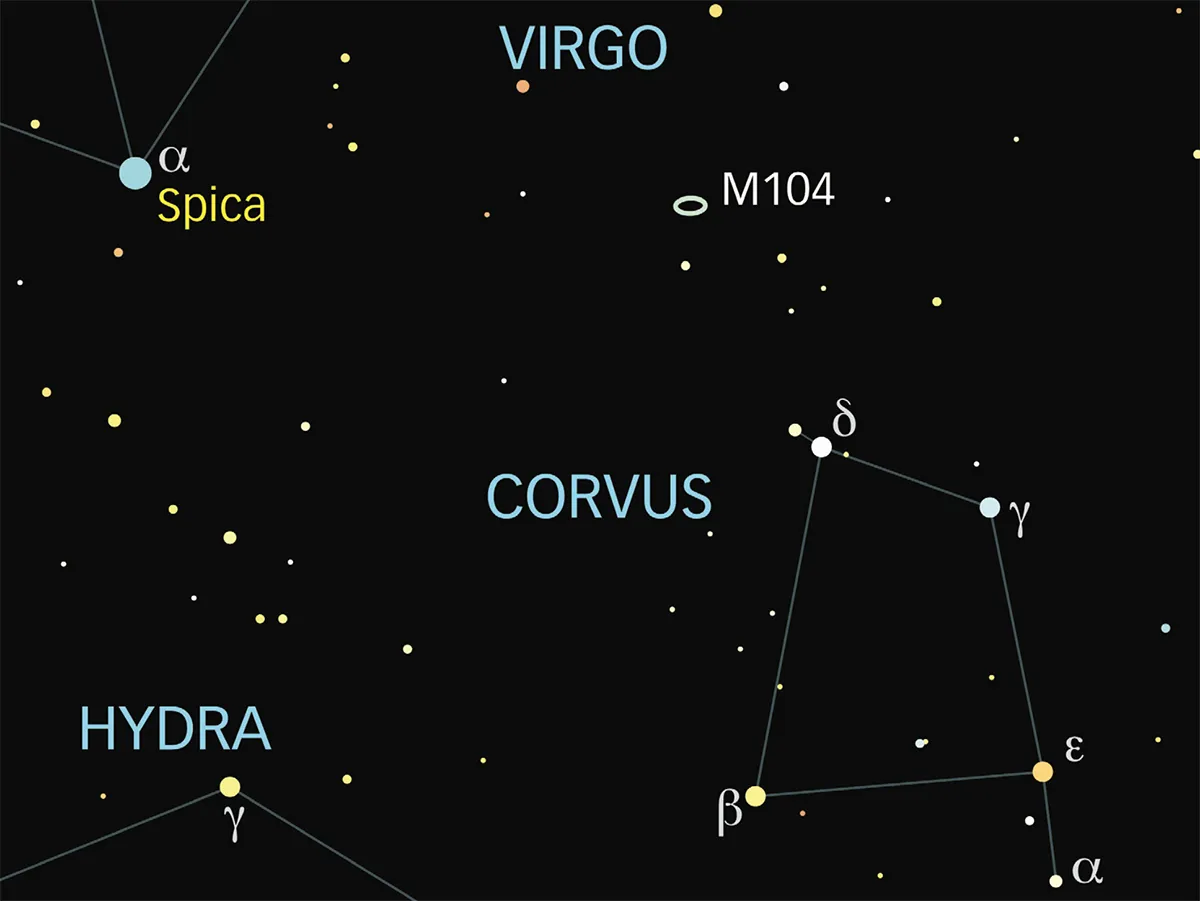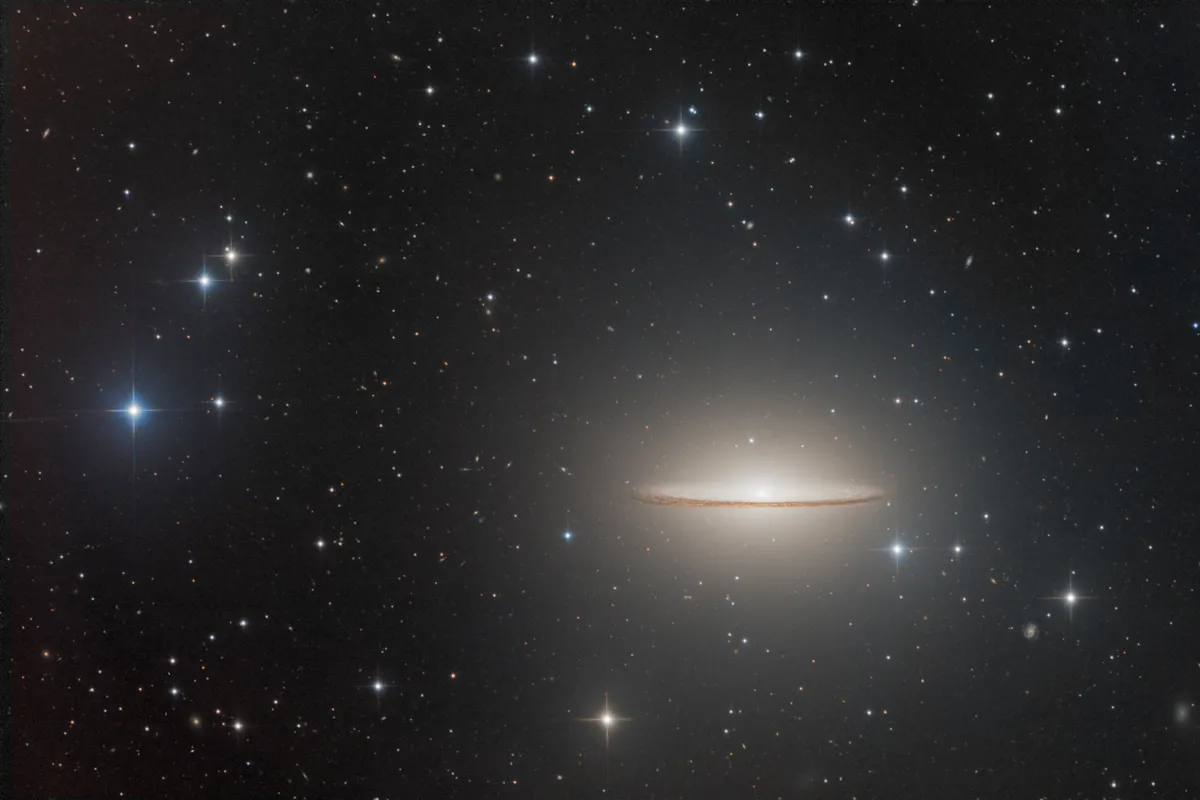Corvus and Crater are two constellations that seem to go hand in hand.
They're located next to one another in the sky and, as is often the case, are also related to one another in terms of their mythology.
As Ian Ridpath explains in his Star Tales website, the story begins with Apollo preparing to make a sacrifice to Zeus and sending a crow - Corvus - to collect water from a spring.
Corvus flies off with a bowl or cup - Crater - in its claws and finds a fig tree full of unripe fruit.

We'll let you read the rest of that particular myth for yourself, and instead focus on some of the best deep-sky objects to be found in Corvus and Crater.
These include the fabulous Sombrero Galaxy, an edge-on galaxy that resembles the famous headwear, and the interacting galaxy pair known as the Antennae Galaxies.
Below is The Sky Night presenter Pete Lawrence's pick of 6 wonderful deep-sky objects in Corvus and Crater.
See how many you can tick off the list, and let us know how you got on (contact details at the bottom of this page).
For help locating the objects, use our Crater and Corvus deep-sky tour chart (PDF).
Happy hunting!
1 - M104

Dan Crowson, remotely via Telescope Live, El Sauce Observatory, Chile, August–September 2022
Equipment: QHY 600M camera, PlaneWave CDK24
We start with the iconic form of M104, the Sombrero Galaxy.
This is a mag. +8.0 side-on peculiar galaxy with a prominent dust lane running south of its equatorial plane.
Locate it by extending the line from Zeta (ζ) Corvi through Algorab (Delta (δ) Corvi) for the same distance to reach the correct area.
A 150mm scope shows a 6 x 2-arcminute glow with a distinctive dark dust lane. Larger scopes will improve the contrast and apparent size.
Lying 31.1 million lightyears away, M104 is unusual for showing characteristics of a spiral galaxy but elements associated with giant ellipticals too.
Take a look at the James Webb Space Telescope image of the Sombrero Galaxy.
2 - NGC 4361

Our next target lies within the distinctive quadrilateral pattern of Corvus formed from Beta (β), Delta (δ), Gamma (γ) and Epsilon (ε) Corvi.
Identify the mid-point between Delta and Zeta Corvi and head 0.8° north to locate the mag. +10.9 planetary nebula NGC 4361.
A 150mm scope shows this as a large circular smudge. The challenge here is to try to see the central star that shines at mag. +13.0.
A 250mm scope has no difficulty and begins to show that the brighter central region is more rectangular in shape and slightly offset to the south.
The central region appears approximately 40 arcseconds across through a 250mm instrument. NGC 4361 lies at a distance of around 3,400 lightyears.
3 - NGC 4027

Algorab again comes in handy for locating our next target, mag. +11.1 face-on galaxy NGC 4027.
To find it, extend the line from Algorab through Gienah (Gamma (γ) Corvi) for the same distance again. NGC 4027 is approximately 0.4° south of the point you arrive at.
A 150mm scope will show a circular patch of light roughly 2 arcminutes across.
Larger instruments will begin to reveal a mottled core and an irregular outline.
NGC 4027 is believed to have been gravitationally perturbed by a fainter 15th-magnitude companion, NGC 4027A to the south.
Also known as Arp 22, this is a barred spiral galaxy 83 million lightyears distant.
4 - NGC 4038 and 4039

The interacting galaxy pair NGC 4038 and NGC 4039, known as the Antennae Galaxies, lie approximately 0.7° northeast of NGC 4027 and may be interacting with that galaxy as well.
A 150mm scope shows the pair as a large, single bright spot 2.5 arcminutes across.
Larger apertures reveal a kidney shape with the two distinct lobes. The northern lobe, NGC 4038, is brightest.
A 300mm scope reveals that NGC 4038’s core contains two main condensations.
Under clear, dark skies, the pair is wonderful to spend time with as more and more detail becomes clear.
A mottled light bridge between the cores is apparent, along with a hint of the extensions that give the pair its informal name.
5 - NGC 3887

Head west from NGC 4038 and 4039 to mag. +5.2 Eta (η) Crateris.
Using this as a navigational base, head 2.1° due west and 0.2° north to arrive at NGC 3887, a mag. +11.0 barred spiral galaxy.
This is a nice, tight object appearing as an elliptical glow 3 x 2 arcminutes in size through a 150mm scope.
A pair of stars lie in the foreground close to the galaxy’s outer halo; these can skew the shape of the galaxy with smaller apertures.
The galaxy’s shape is very obvious through a 250mm scope, the outline showing a ragged appearance and the core appearing fairly uniform with only a subtle hint of a central concentration.
6 - NGC 3962

Our final target is a little tricky due to its low brightness.
Find NGC 3962 3.4° northeast of NGC 3887 or use easier-to-locate Eta Crateris as a base, head 3.2° north and 0.5° west to reach this mag. +12.2 elliptical galaxy.
The galaxy appears as an elliptical glow through a 250mm scope, its centre forming one vertex of a right-angled triangle with two 10th-magnitude stars further to the south.
Larger instruments show little in the way of detail apart from the bright inner core, a 300mm instrument showing a 3 x 1-arcminute glow.
NGC 3962 is estimated to be an impressive 105 million lightyears distant.
Let us know how many deep-sky objects in Crater and Corvus you were able to observe by emailing contactus@skyatnightmagazine.com


